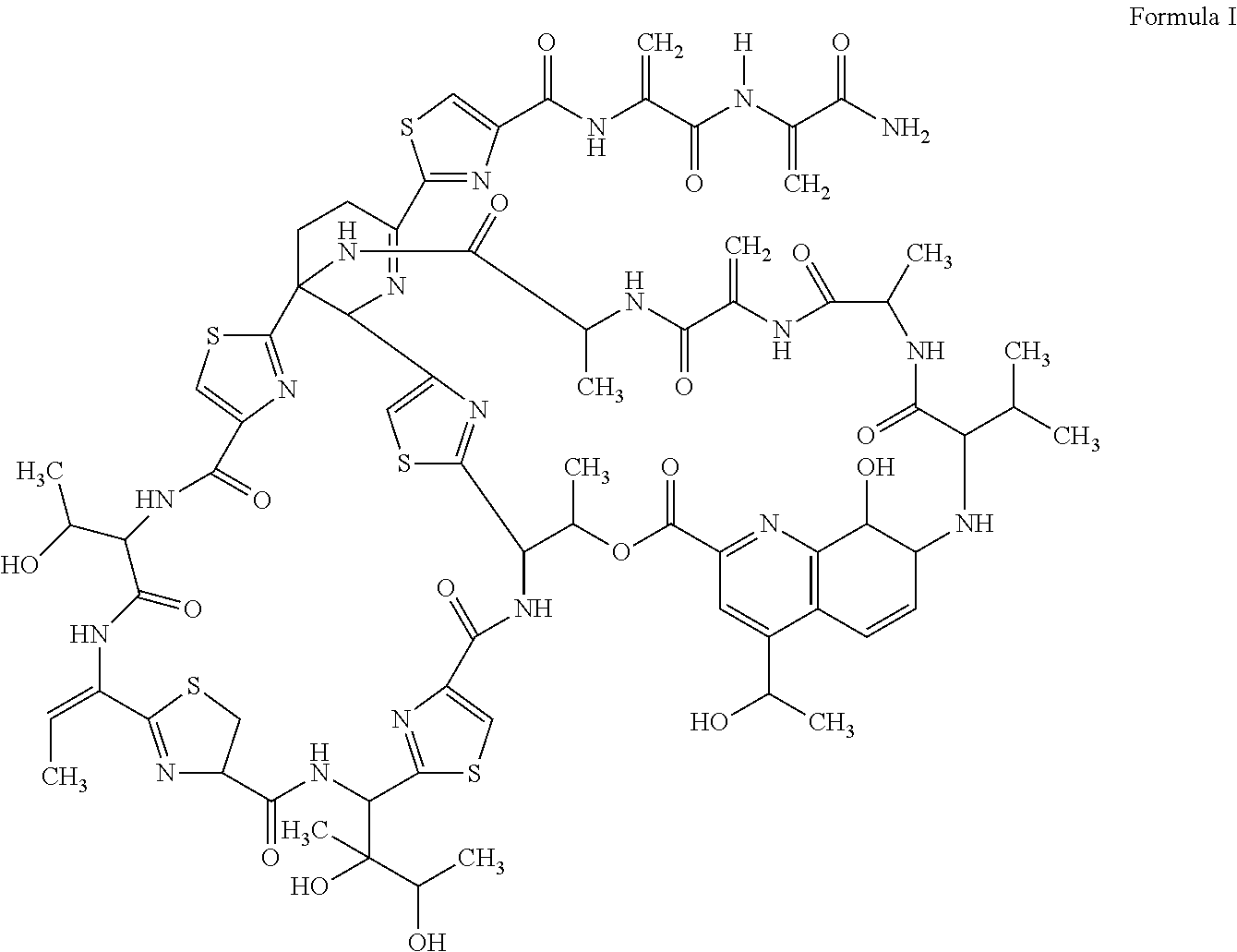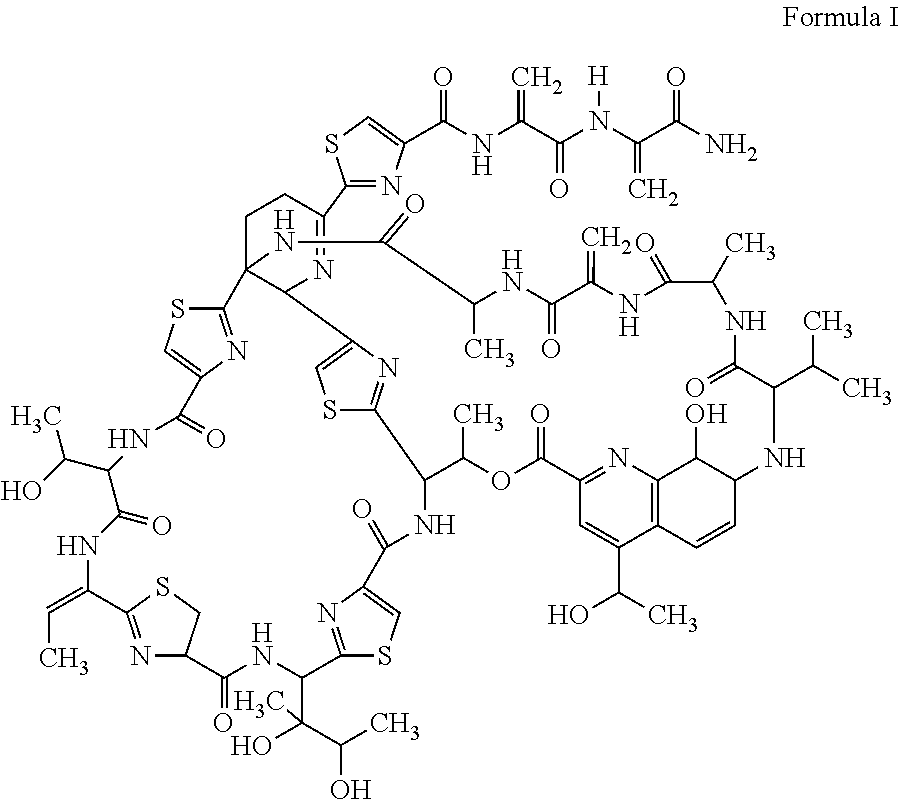Microparticle formulation for pulmonary drug delivery of anti infective molecule for treatment of infectious diseases
a technology of infectious diseases and microparticles, which is applied in the direction of respiratory disorders, cyclic peptide ingredients, medical atomisers, etc., can solve the problems of poor patient compliance, poor bioavailability in the lungs, and detrimental to disease eradication, and achieve the effect of reducing drug-associated systemic toxicity
- Summary
- Abstract
- Description
- Claims
- Application Information
AI Technical Summary
Benefits of technology
Problems solved by technology
Method used
Image
Examples
example 1
Isolation of Culture No. PM0626271 from Soil Collected from Antarctic Region
a) Composition of the isolation medium:
Modified artificial sea water agar: Peptone 1.5 g, yeast extract 0.5 g, ferric chloride 0.007 g, 1.0 L water (750 mL artificial sea water+250 mL demineralised water), agar powder 15.0 g, final pH (at 25° C.) 7.4 to 7.8.
[0122]Composition of the artificial seawater: Sodium chloride 24.6 g, potassium chloride 0.67 g, calcium chloride.2H2O 1.36 g, magnesium sulphate.7H2O 6.29 g, magnesium chloride.6H2O 4.66 g, sodium bicarbonate 0.18 g, demineralised water 1.0 L, final pH (at 25° C.) 7.8 to 8.2.
b) Procedure:
From Schirmacher Oasis region in Antarctica area, surface level soil was collected and was stored at −20° C. throughout the journey to Piramal Life Sciences Limited, Goregaon, Mumbai, India. The sample was stored at −20° C. to −22° C. and later thawed to room temperature (25±2° C.) for isolation of the microbes. The soil sample (˜1 g) was suspended in 25 mL of sterile 1%...
example 2
Purification of Culture No. PM0626271
a) Composition of the purification medium (Actinomycete Isolation Agar, agarified by 1.5% agar agar):
[0123]Glycerol 5.0 mL, sodium caseinate 2.0 g, L-asparagine 0.1 g, sodium propionate 4.0 g, dipotassium phosphate 0.5 g, magnesium sulphate 0.1 g, ferrous sulphate 0.001 g, 1.0 L water (750 mL Artificial Sea Water+250 mL demineralised water), agar powder 15.0 g, final pH (at 25° C.) 7.4 to 7.8.
Composition of the artificial seawater: Sodium chloride 24.6 g, potassium chloride 0.67 g, calcium chloride.2H2O, 1.36 g, magnesium sulphate.7H2O 6.29 g, magnesium chloride.6H2O 4.66 g, sodium bicarbonate 0.18 g, demineralized water 1.0 L, final pH (at 25° C.) 7.8 to 8.2.
b) Procedure:
The culture no. PM0626271 was streaked on Actinomycete Isolation Agar (containing 75% artificial sea water salts) petriplate. The petriplate was incubated for 10 days at 25° C. One of the isolated colonies from the petriplate was transferred to fresh slants of Actinomycete Isola...
example 3
Maintenance of Producer Strain—Culture No. PM0626271
a) Composition of the medium (Actinomycete Isolation Agar):
[0124]Glycerol 5.0 mL, sodium caseinate 2.0 g, L-asparagine 0.1 g, sodium propionate 4.0 g, dipotassium phosphate 0.5 g, magnesium sulphate 0.1 g, ferrous sulphate 0.001 g, 1.0 L water (750 mL artificial sea water+250 mL demineralised water), agar powder 15.0 g, final pH (at 25° C.) 7.4 to 7.8.
Composition of the artificial sea water: Sodium chloride 24.6 g, potassium chloride 0.67 g, calcium chloride.2H2O 1.36 g, magnesium sulphate.7H2O 6.29 g, magnesium chloride.6H2O 4.66 g, sodium bicarbonate 0.18 g, demineralized water 1.0 L, final pH (at 25° C.) 7.8 to 8.2.
b) After dissolving the ingredients thoroughly by heating, the resultant solution was distributed in test tubes and sterilized at 121° C. for 30 minutes. The test tubes were cooled and allowed to solidify in a slanting position. The agar slants were streaked with the growth of culture no. PM0626271 by a wire loop and ...
PUM
| Property | Measurement | Unit |
|---|---|---|
| particle size | aaaaa | aaaaa |
| particle size | aaaaa | aaaaa |
| phase transition temperature | aaaaa | aaaaa |
Abstract
Description
Claims
Application Information
 Login to View More
Login to View More - R&D
- Intellectual Property
- Life Sciences
- Materials
- Tech Scout
- Unparalleled Data Quality
- Higher Quality Content
- 60% Fewer Hallucinations
Browse by: Latest US Patents, China's latest patents, Technical Efficacy Thesaurus, Application Domain, Technology Topic, Popular Technical Reports.
© 2025 PatSnap. All rights reserved.Legal|Privacy policy|Modern Slavery Act Transparency Statement|Sitemap|About US| Contact US: help@patsnap.com



